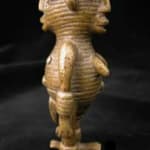Chadian Brass Janiform Sculpture, 19th Century CE - 20th Century CE
Brass
3.875
PF.6287
Further images
This charming bronze sculpture depicts a standing figure with both male and female characteristics. Called janiform, the work actually appears to be a male and female individual who have been...
This charming bronze sculpture depicts a standing figure with both male and female characteristics. Called janiform, the work actually appears to be a male and female individual who have been fused together at their backs. Certain creation myths detail the first humans, who were created in the form of a man and woman joined at the shoulders and separated by the axe of god. This sculpture seems to replicate such an idea, although its relation to this myth is pure speculation. The body features wide, flat feet that make both sides appear to be front views. Decorative jewelry depicted as a series of ringed bands decorate the arms and legs. This same motif is repeated over the torso and head of the figure, which may be indicative of ritual scarification. The female half has long, narrow breasts that fall over her chest. The male has two flat bumps for his nipples, these bumps are also used to represent the navels on both halves. Their figure’s faces are represented identically, with coffee-bean eyes, a broad trapezoidal nose, and a slightly open mouth. Janiform sculptures are produced by many different tribes across the African continent. They are important both for their symbolism as well as their unique aesthetic beauty. This work comes from the crossroads of Chad, where Islamic traders from Northern Africa influenced the arts and culture of the native animist tribes of Sub-Sahara Africa.







